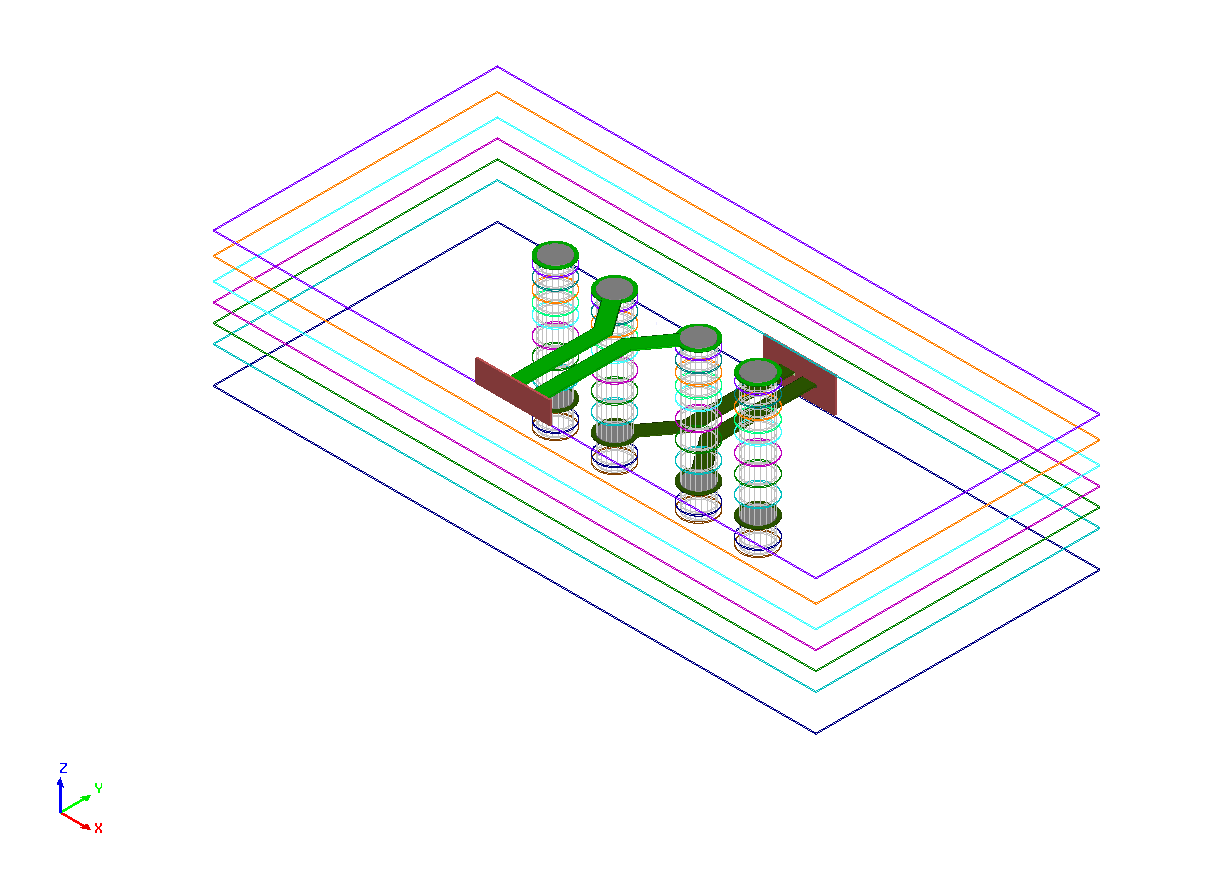EDB: geometry creation#
This example shows how you can use EDB to create a layout. ## Final expected project

Import EDB layout object#
Import the EDB layout object and initialize it on version 2023 R2.
[1]:
import os
import tempfile
import pyedb
temp_dir = tempfile.TemporaryDirectory(suffix=".ansys")
aedb_path = os.path.join(temp_dir.name, "create_via.aedb")
print(f"AEDB file path: {aedb_path}")
# Select EDB version (change it manually if needed, e.g. "2024.2")
edb_version = "2024.2"
print(f"EDB version: {edb_version}")
edb = pyedb.Edb(edbpath=aedb_path, edbversion=edb_version)
AEDB file path: C:\Users\ansys\AppData\Local\Temp\tmp303qofq2.ansys\create_via.aedb
EDB version: 2024.2
PyEDB INFO: StdOut is enabled
PyEDB INFO: Logger is initialized in EDB.
PyEDB INFO: legacy v0.35.dev0
PyEDB INFO: Python version 3.10.11 (tags/v3.10.11:7d4cc5a, Apr 5 2023, 00:38:17) [MSC v.1929 64 bit (AMD64)]
PyEDB INFO: EDB C:\Users\ansys\AppData\Local\Temp\tmp303qofq2.ansys\create_via.aedb created correctly.
PyEDB INFO: EDB initialized.
Add stackup layers#
Add stackup layers. A stackup can be created layer by layer or imported from a CSV file or XML file.
[2]:
edb.stackup.add_layer("GND")
edb.stackup.add_layer("Diel", "GND", layer_type="dielectric", thickness="0.1mm", material="FR4_epoxy")
edb.stackup.add_layer("TOP", "Diel", thickness="0.05mm")
[2]:
<pyedb.dotnet.edb_core.edb_data.layer_data.StackupLayerEdbClass at 0x1bb2591d120>
Create signal net and ground planes#
Create a signal net and ground planes.
[3]:
points = [[0.0, 0], [100e-3, 0.0]]
edb.modeler.create_trace(points, "TOP", width=1e-3)
points = [[0.0, 1e-3], [0.0, 10e-3], [100e-3, 10e-3], [100e-3, 1e-3], [0.0, 1e-3]]
edb.modeler.create_polygon(points, "TOP")
points = [[0.0, -1e-3], [0.0, -10e-3], [100e-3, -10e-3], [100e-3, -1e-3], [0.0, -1e-3]]
edb.modeler.create_polygon(points, "TOP")
[3]:
<pyedb.dotnet.edb_core.edb_data.primitives_data.EdbPolygon at 0x1bb258d3700>
Create vias with parametric positions#
Create vias with parametric positions.
[4]:
edb.padstacks.create("MyVia")
edb.padstacks.place([5e-3, 5e-3], "MyVia")
edb.padstacks.place([15e-3, 5e-3], "MyVia")
edb.padstacks.place([35e-3, 5e-3], "MyVia")
edb.padstacks.place([45e-3, 5e-3], "MyVia")
edb.padstacks.place([5e-3, -5e-3], "MyVia")
edb.padstacks.place([15e-3, -5e-3], "MyVia")
edb.padstacks.place([35e-3, -5e-3], "MyVia")
edb.padstacks.place([45e-3, -5e-3], "MyVia")
PyEDB INFO: Padstack MyVia create correctly
[4]:
<pyedb.dotnet.edb_core.edb_data.padstacks_data.EDBPadstackInstance at 0x1bb258d2c20>
Generate geometry plot#
[5]:
edb.nets.plot(None, color_by_net=True)
PyEDB INFO: Plot Generation time 0.109
[5]:
(<Figure size 6000x3000 with 1 Axes>, <Axes: title={'center': 'Edb Top View'}>)

Generate stackup plot#
[6]:
edb.stackup.plot(plot_definitions="MyVia")
C:\actions-runner\_work\pyedb\pyedb\.venv\lib\site-packages\pyedb\dotnet\edb_core\stackup.py:2868: UserWarning: FigureCanvasAgg is non-interactive, and thus cannot be shown
plt.show()
[6]:
<module 'matplotlib.pyplot' from 'C:\\actions-runner\\_work\\pyedb\\pyedb\\.venv\\lib\\site-packages\\matplotlib\\pyplot.py'>
Save and close EDB#
Save and close EDB.
[7]:
if edb:
edb.save_edb()
edb.close_edb()
print("EDB saved correctly to {}. You can import in AEDT.".format(aedb_path))
PyEDB INFO: EDB file save time: 0.00ms
PyEDB INFO: EDB file release time: 0.00ms
EDB saved correctly to C:\Users\ansys\AppData\Local\Temp\tmp303qofq2.ansys\create_via.aedb. You can import in AEDT.
Clean up temporary directory#
The following command removes the project and the temporary directory. If you’d like to save this project, save it to a folder of your choice prior to running the following cell.
[8]:
temp_dir.cleanup()
